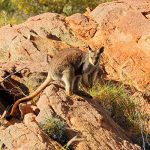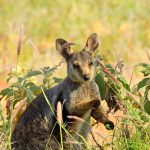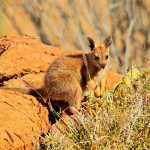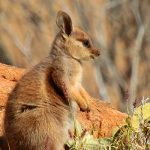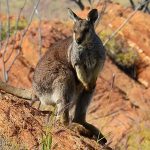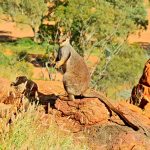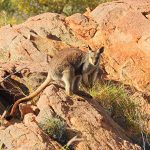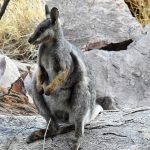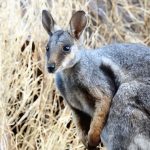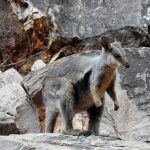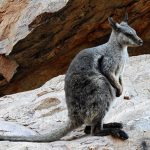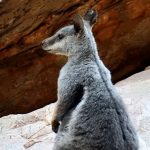The Black-flanked rock-wallaby, is also known as the Black-footed rock-wallaby or Warru. It is a remarkable marsupial native to Australia.
These agile creatures are primarily found in rocky outcrops and rugged escarpments across parts of Western Australia, South Australia, and the Northern Territory. Their preference for steep, rocky terrain provides them with natural protection from predators and harsh weather conditions.
Black-flanked rock-wallabies are incredible climbers. Their strong hind legs and long tail provide balance and agility, allowing them to navigate their rocky homes with ease. They are primarily nocturnal, spending the daytime resting in the shade of rocks and becoming active during the cooler evening hours.
These rock-wallabies are herbivores, feeding primarily on grasses, leaves, and shrubs. Their diet can vary depending on the availability of vegetation in their rocky habitats. They have adapted to survive in arid environments, often obtaining moisture from the plants they consume, which allows them to endure long periods without direct water sources.
The breeding habits of the Black-flanked rock-wallaby are quite fascinating. Females typically give birth to a single joey after a gestation period of about 30 days. The tiny, underdeveloped joey then makes its way to the mother’s pouch, where it continues to grow and develop for several months. After leaving the pouch, the joey remains close to its mother, gradually gaining independence.
Black-flanked rock-wallabies have an average lifespan of around 10-12 years in the wild.
Sadly, the Black-flanked rock-wallaby is listed as Endangered . Habitat destruction, predation by introduced species like foxes and feral cats, and competition with livestock for food have all contributed to their declining numbers. Conservation efforts, including predator control and habitat restoration, are crucial to ensuring their survival.
The Black-flanked rock-wallaby, or Warru, holds cultural significance for several Aboriginal communities. For example, the Anangu people of Central Australia have traditional stories and knowledge about the Warru, and they have been actively involved in conservation efforts to protect these animals. The Warru is not only a part of their natural heritage but also a symbol of resilience and survival in the harsh Australian landscape.
Conservation programs, such as the Warru Recovery Project, involve collaborations between Aboriginal communities, government agencies, and conservation organisations. These programs focus on habitat restoration, predator control, and breeding programs to help boost the population of these endangered wallabies.
The Black-flanked rock-wallaby is a remarkable and resilient species that plays a vital role in Australia’s natural heritage. Through continued conservation efforts and the involvement of Indigenous communities, there is hope for the future of this unique marsupial. By learning about and supporting these initiatives, we can all contribute to the preservation of the Warru and the rich biodiversity of Australia.

